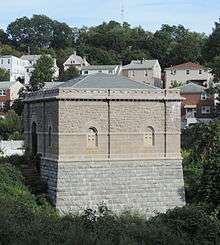New Croton Aqueduct
The New Croton Aqueduct is an aqueduct in the New York City water supply system in Westchester County, New York carrying the water of the Croton Watershed. Built roughly parallel to the Old Croton Aqueduct it originally augmented, it opened in 1910. The old aqueduct remained in service until 1955, when supply from the Delaware and Catskill Aqueducts was sufficient to take it off line.

Waters of the New Croton Aqueduct flow to the Jerome Park Reservoir in the Bronx before entering Croton Water Filtration Plant in Van Cortlandt Park for treatment, then out to distribution.
History
The Croton Watershed is one of three systems that provide water to New York City, joined by the waters of the Delaware and Catskill Aqueducts.[1]

The New Croton Aqueduct opened on July 15, 1890,[2] replacing the Old Croton Aqueduct. It runs from the New Croton Reservoir in Westchester County to the Jerome Park Reservoir in the Bronx. Water flows then proceed toward the Croton Water Filtration Plant for treatment. Treated water is then distributed to certain areas of the Bronx and Manhattan.
In the late 1990s, New York City stopped using water from the Croton due to numerous water quality issues. In 2004, a project was started to rehabilitate the New Croton Aqueduct and build a filtration plant, the Croton Water Filtration Plant in Van Cortlandt Park, which was activated in May 2015.[3] Because of these quality problems, the Croton system is bypassed or mixed with water from the Catskill Aqueduct and/or Delaware Aqueduct during times of drought. The project is over budget and behind schedule.[4]
References
- "The Croton Water Filtration Plant Project". NYC.gov. Retrieved 1 Dec 2014.
- "The New Aqueduct Opened; Water Flowing at One-Third the Reservoir's Capacity". The New York Times. July 16, 1890. Retrieved 2011-03-17.
- https://csengineermag.com/nyc-dep-activates-croton-water-filtration-plant/
- Gonzalez, Juan (25 Jun 2013). "Ten years later, Croton Water Filtration Plant deal to invest in parks, playgrounds a mess of broken promises". NYdailynews.com. Retrieved 1 Dec 2014.
External links
| Wikimedia Commons has media related to Water supply system of New York City. |
- History of NYC's Drinking Water at NYC.gov
- New York City's Water Story: From Mountain Top to Tap at NYC.gov